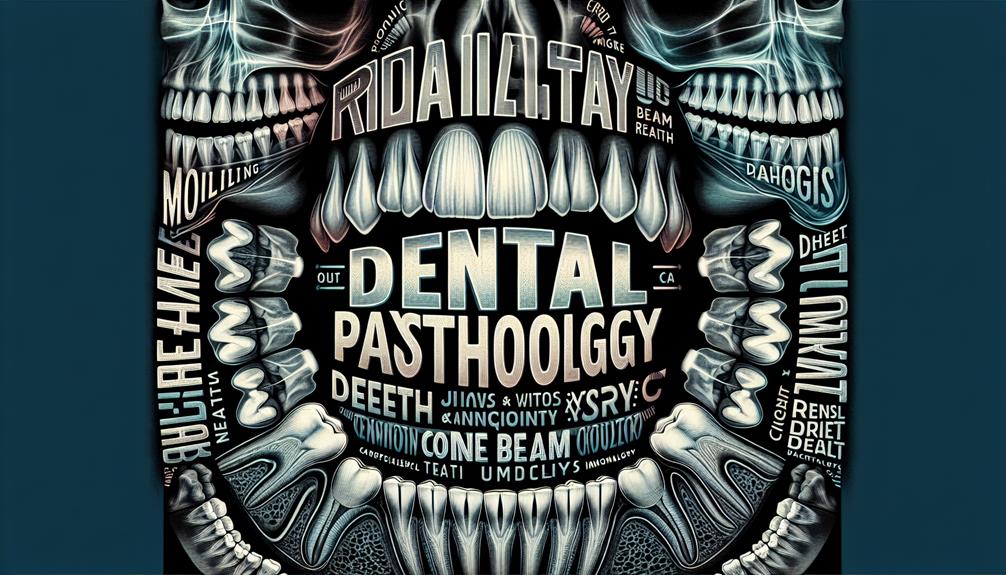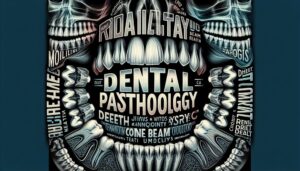To enhance your online visibility, focus on these top 10 keywords: Dental X-rays, Oral Imaging, Radiographic Interpretation, Cone Beam CT, Dental Radiology, Digital Radiography, Oral Pathology Imaging, Radiographic Techniques, Radiology Reports. Optimizing your content with these targeted keywords will boost your rankings and relevance in the digital realm. Mastering these keywords is crucial for success in the competitive field of oral radiology and ensuring your practice stands out. By incorporating these key terms strategically, you can attract more traffic and establish yourself as an authority in the industry.
Key Takeaways
- Dental X-rays positioning
- Cone Beam CT applications
- AI in Oral Imaging
- Radiographic interpretation skills
- Continuous learning in radiology
Dental X-rays
When taking dental x-rays, ensure proper positioning for accurate results. Radiographic interpretation challenges may arise due to improper positioning, leading to inaccuracies in diagnosing oral conditions.
Dental x-ray safety is paramount to protect both patients and staff from unnecessary radiation exposure. To address these challenges, staying updated on oral imaging innovations is crucial.
One such innovation is cone beam technology, which provides detailed 3D images of the oral structures with lower radiation doses compared to traditional x-rays.
Oral Imaging
To enhance diagnostic accuracy in oral radiology, mastering the principles of oral imaging is essential. Stay updated on oral radiology advancements and future trends to ensure you're utilizing the latest technology and techniques for improved patient care.
In the field of oral imaging, the role of artificial intelligence (AI) is becoming increasingly prominent. AI can assist in analyzing images quickly and accurately, aiding in the detection of abnormalities that may be overlooked by the human eye alone. By embracing AI in oral imaging practices, you can enhance efficiency and potentially reduce diagnostic errors.
Understanding how artificial intelligence integrates with oral imaging can help you streamline your workflow and provide more precise diagnoses to your patients. Stay informed about the latest developments in AI technology within oral radiology to stay at the forefront of advancements in the field.
Radiographic Interpretation
Mastering radiographic interpretation is crucial for oral radiologists to accurately diagnose and treat patients. Understanding radiographic findings is essential in deciphering the intricacies of oral health issues. By employing various radiographic interpretation techniques, oral radiologists can identify abnormalities, lesions, and other pathologies that may not be immediately apparent. These techniques involve analyzing shapes, densities, and textures within the images to pinpoint potential problems accurately.
Radiographic findings provide valuable insights into the underlying conditions affecting a patient's oral health. By honing your skills in radiographic interpretation, you can make informed decisions regarding treatment plans and interventions. Recognizing subtle nuances in radiographic images can lead to early detection of diseases and abnormalities, ultimately improving patient outcomes.
Stay updated on the latest advancements in radiographic interpretation techniques to enhance your diagnostic capabilities further. Continuous learning and practice are key to mastering the art of interpreting radiographic findings accurately. By prioritizing this aspect of your practice, you can elevate the quality of care you provide to your patients.
Cone Beam CT
Understanding the significance of Cone Beam CT technology is vital for oral radiologists seeking to enhance their diagnostic capabilities and treatment planning. Cone beam technology, also known as CBCT, offers three-dimensional imaging that provides detailed views of the oral and maxillofacial structures. This advanced technology allows for precise assessment of anatomical structures, aiding in the detection of pathologies, planning for dental implant placement, evaluating temporomandibular joint disorders, and assessing airway anatomy for sleep apnea management.
CBCT applications in oral radiology have revolutionized the field by offering high-quality images with minimal radiation exposure compared to traditional CT scans. With its ability to capture detailed cross-sectional images, CBCT enhances the visualization of complex dental structures, enabling more accurate diagnoses and treatment planning.
Incorporating CBCT technology into your practice can lead to improved patient outcomes and enhanced efficiency in managing a wide range of dental conditions. Stay updated on the latest advancements in cone beam technology to provide optimal care for your patients.
Dental Radiology
You need to understand the key points regarding imaging techniques in dentistry, the significance of dental X-rays, and the latest radiology advancements in dentistry.
Dental radiology plays a crucial role in diagnosing and treating oral conditions, making it essential for oral radiologists to stay updated on these developments.
Imaging Techniques in Dentistry
When considering imaging techniques in dentistry, it's essential to understand the various tools and technologies available for accurate diagnosis and treatment planning. Radiographic imaging applications play a crucial role in capturing detailed images of the oral cavity and surrounding structures. These images aid in detecting dental issues such as cavities, infections, and bone abnormalities.
Oral radiology advancements have significantly improved the quality and efficiency of dental imaging processes. With modern technology, dentists can now obtain clearer images with lower radiation exposure, enhancing patient safety. By staying updated on the latest oral radiology advancements, dental professionals can provide better care and more precise treatment plans tailored to each patient's unique needs.
Importance of Dental X-Rays
Dental X-Rays play a crucial role in diagnosing and planning treatments for oral health issues. Oral Radiologist Benefits are evident as these imaging techniques provide detailed insights into the structures of the mouth, helping in accurate diagnosis and treatment planning.
X-Ray Accuracy is crucial for identifying dental problems such as cavities, infections, and bone loss that may not be visible during a regular oral examination.
Ensuring Patient Safety, X-Ray Frequency is carefully monitored to minimize radiation exposure while still obtaining essential diagnostic information.
Radiology Advancements in Dentistry
Radiology advancements in dentistry have revolutionized the way oral health issues are diagnosed and treated, offering cutting-edge technology for more precise imaging and analysis.
Radiology software integration plays a crucial role in enhancing workflow efficiency and streamlining image processing. This integration allows for seamless communication between different dental specialties, enabling comprehensive patient care.
Moreover, radiology in orthodontics has significantly advanced treatment planning by providing detailed insights into craniofacial structures and tooth alignment. By utilizing radiographic images, orthodontists can create personalized treatment strategies that yield optimal results.
These advancements in dental radiology not only improve diagnostic accuracy but also contribute to enhancing patient outcomes and satisfaction.
Panoramic Radiograph
Taking a panoramic radiograph provides a comprehensive view of the entire oral structures in a single image. Panoramic radiographs offer several benefits, such as capturing the entire dentition, supporting structures, and temporomandibular joints in one image. This can aid in diagnosing issues like impacted teeth, jaw fractures, and oral infections. However, panoramic radiographs have limitations, including lower resolution compared to intraoral x-rays, which may make it challenging to detect small cavities or periodontal problems.
When comparing panoramic radiographs to traditional x-rays, the former provides a broader view of the oral cavity, making it ideal for assessing overall oral health and identifying abnormalities in the jaw or sinuses. On the other hand, traditional x-rays offer higher detail and precision for specific areas of interest, such as individual teeth or localized dental problems. Understanding the differences between these imaging techniques can help oral radiologists choose the most suitable option based on the patient's needs.
Digital Radiography
Consider how digital radiography revolutionizes the way oral radiologists capture and interpret images of the oral cavity with enhanced precision and efficiency. Digital radiography offers numerous benefits, including improved image quality, lower radiation exposure for patients, and the ability to digitally store and easily share images.
This technology allows for quick image processing, enhancing workflow and reducing the time needed to obtain diagnostic information.
Looking ahead, future trends in oral imaging suggest that digital radiography will continue to evolve. Advancements in software algorithms and artificial intelligence are expected to further enhance image analysis and interpretation. Additionally, the integration of 3D imaging capabilities into digital radiography systems is anticipated to provide even more comprehensive views of the oral structures.
Oral Pathology Imaging
Utilize advanced imaging techniques to pinpoint and analyze oral pathology with enhanced precision and detail. Oral pathology diagnosis relies heavily on various imaging techniques to aid in accurate assessments. Radiographic interpretation plays a pivotal role in oral pathology detection, allowing oral radiologists to identify and evaluate abnormalities within the oral cavity. By employing advanced imaging modalities such as cone-beam computed tomography (CBCT) or magnetic resonance imaging (MRI), oral pathologies can be visualized in three dimensions, providing a comprehensive view for diagnosis and treatment planning.
CBCT is particularly useful in assessing bony structures and detecting lesions not visible on conventional radiographs. MRI, on the other hand, is beneficial for evaluating soft tissues and detecting changes in the surrounding structures. These imaging techniques contribute significantly to the early detection and precise localization of oral pathologies, enabling prompt intervention and improved patient outcomes. Therefore, mastering radiographic interpretation in oral pathology imaging is essential for accurate diagnosis and effective treatment planning.
Radiographic Techniques
When it comes to radiographic techniques, you need to grasp the fundamentals of imaging technology, perfect your positioning and exposure skills, and master the art of diagnostic image analysis.
These three key points are essential for capturing high-quality images that aid in accurate diagnosis and treatment planning.
Imaging Technology Overview
Exploring the various radiographic techniques is essential for oral radiologists to effectively assess and diagnose dental conditions. Keeping up with imaging technology advancements and diagnostic tools is crucial in providing accurate diagnoses. The role of artificial intelligence in oral radiology is increasingly significant, paving the way for future trends in the field.
Artificial intelligence can aid in image analysis, pattern recognition, and even decision-making processes, enhancing the efficiency and accuracy of diagnoses. As an oral radiologist, staying informed about these technological developments and incorporating them into your practice can greatly enhance the quality of patient care. Embracing these advancements ensures that you're at the forefront of utilizing cutting-edge tools to improve diagnostic capabilities and treatment outcomes.
Positioning and Exposure
To achieve optimal radiographic results in oral radiology, mastering precise positioning and exposure techniques is paramount. Proper positioning techniques ensure that the desired anatomy is captured accurately on the image, reducing the need for retakes and minimizing patient exposure to radiation.
Understanding exposure settings is crucial in controlling the contrast and brightness of the radiograph, allowing for detailed visualization of structures of interest. By fine-tuning your positioning techniques and adjusting exposure settings accordingly, you can enhance the quality of diagnostic images, aiding in accurate diagnosis and treatment planning.
Regular practice and ongoing education in positioning and exposure will sharpen your skills, making you a proficient oral radiologist in capturing high-quality radiographs.
Diagnostic Image Analysis
Mastering radiographic techniques for diagnostic image analysis is key in enhancing your ability to interpret oral radiographs effectively.
Stay updated with machine learning applications and 3D imaging innovations to improve your diagnostic accuracy. Machine learning applications can assist in automating certain tasks like image segmentation and pattern recognition, streamlining your workflow.
Embracing 3D imaging innovations allows for more comprehensive views of oral structures, aiding in the detection of pathologies that may not be as apparent in traditional 2D radiographs.
By incorporating these advanced technologies into your practice, you can elevate the quality of your diagnostic image analysis and provide more precise and efficient patient care.
Keep exploring these evolving tools to stay at the forefront of oral radiology practice.
Radiology Reports
When preparing radiology reports, ensure you include all relevant findings and interpretations for accurate diagnosis and treatment planning.
Staying updated on radiology software trends is crucial for efficient report generation and analysis. Incorporating the latest advancements in radiology software can streamline the reporting process, enhance image visualization, and improve overall diagnostic accuracy.
Additionally, understanding oral radiologist career insights can provide valuable perspective on the importance of comprehensive and detailed radiology reports. As an oral radiologist, your reports play a vital role in communicating critical information to other healthcare professionals, guiding treatment decisions, and ultimately impacting patient outcomes.
Frequently Asked Questions
How Can Oral Radiologists Minimize Radiation Exposure During Imaging Procedures?
To minimize radiation exposure during imaging procedures, you must follow radiation safety protocols and utilize techniques aimed at minimizing exposure. Prioritize patient safety by implementing these essential steps in your practice to safeguard against unnecessary radiation exposure risks.
What Are the Common Errors to Avoid When Interpreting Dental X-Rays?
When interpreting dental x-rays, be alert for common pitfalls. Utilize precise interpretation techniques to avoid errors. Remember to double-check findings and consider all factors. Your thoroughness ensures accurate diagnoses and effective treatment plans.
Is There a Specific Protocol for Imaging Patients With Dental Implants?
When imaging patients with dental implants, ensure implant stability by following a specific protocol. Radiographic evaluation plays a crucial role in assessing bone quality. Utilize advanced imaging techniques to capture detailed images for accurate diagnosis and treatment planning.
How Can Oral Radiologists Differentiate Between Benign and Malignant Lesions on Radiographs?
To differentiate between benign and malignant lesions on radiographs, focus on the radiographic features. Enhance your diagnostic accuracy by studying subtle differences in appearance. With practice, you'll become adept at distinguishing between the two types of lesions.
What Advancements Are Being Made in 3D Imaging Technology for Oral Radiology?
You'll be amazed at how 3D imaging technology is revolutionizing oral radiology. Virtual reality applications and artificial intelligence are enhancing radiographic analysis, providing clearer insights into dental structures and pathologies for more precise diagnoses.
Conclusion
In conclusion, mastering these top 10 keywords will help boost your website rankings as an oral radiologist.
By focusing on Dental X-rays, Cone Beam CT, and Radiographic Techniques, you can attract more traffic and increase your online visibility.
Remember, utilizing these key terms is crucial for climbing the search engine ladder and standing out in the competitive world of oral radiology.
So start strategizing and see your rankings rise!

Suraj Rana is a renowned Dental SEO Expert, deeply committed to elevating dental practices in the online landscape. With a profound understanding of technical SEO, he specializes in tailoring on-page optimization strategies specifically for the dental industry. Suraj’s extensive experience spans across various sectors, but his passion truly lies in transforming the digital presence of dental clinics. His expertise in dental-specific search engine optimization, combined with a data-driven approach, empowers him to develop strategies that significantly increase organic traffic, enhance search engine rankings for dental-related keywords, and ultimately drive business growth for his dental clients. Suraj Rana’s unique blend of SEO skills and dedication to the dental field make him an invaluable asset to any dental practice looking to thrive online.


